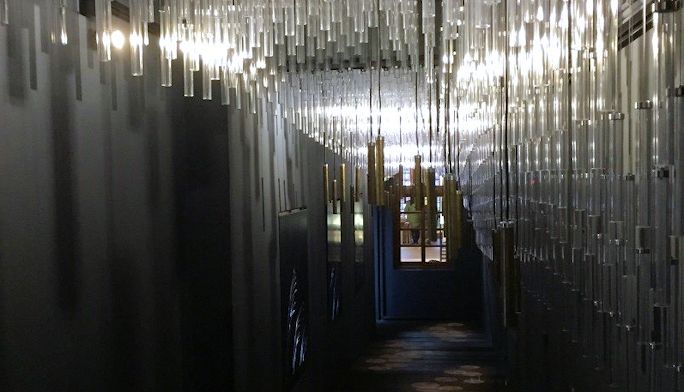A Comparison between the International Slavery Museum and AMA Museum: With a Focus on Engagement and Narratives
by Xiaoyang Hao, Kyushu University
Standing in the room, I could not help feeling nausea and sea-sickness. I was at the recreation of the Middle Passage journey of the Transatlantic slave trade in the International Slavery Museum (ISM), with the walls on both/all sides projected with motion images of enslaved African people moaning and vomiting in pain on a slave ship. In this cramped, stuffy, and suffocating space, the slaves were forced to lie down with their feet, hands, and necks shackled. A slight movement made by one slave would cause extreme discomfort to all the others who were bound together. After standing in this room for a while, a visitor is likely to feel vicariously the sufferings imposed upon the enslaved Africans and thus think more critically about the slavery system.

Image: Projectors of names of victims (photo by the author)
Visiting the ISM and participating in a variety of slavery remembrance activities were important parts of the RENKEI workshop themed on Transatlantic slavery and slavery-like practices, which was held at the University of Liverpool from 17 August to 26 August 2017. As a Ph.D. student specializing in modern Japanese and Chinese history, my research project focuses on justice for victims of sexual violence in Japanese occupied China during WWII and the issue of “comfort women,” a euphemism denoting women and girls forced into sexual slavery by the Japanese military during WWII. The comfort women issue and transatlantic slavery are two examples of massive human rights abuses, and the past few decades have witnessed efforts at civil society and government level to address these past wrongs for reconciliation, which requires justice, apology, reparations, and commemoration. Museums, as sites of memory, are one of the many mediums for commemoration.
The Torreon Declaration in 2009 states that museums should strive to promote diversity, human rights, respects, and equality, as Francoise McClafferty from Federation of International Human Rights Museums (FIHRM) told us in her presentation. It means that museums as public places should inform, engage, and educate, and should assume an active role in promoting certain values among its visitors, which corresponds to the clear political stance taken by the ISM. Its director, Richard Benjamin also stated that the museum is neither a safe zone, nor a neutral organization. This raises the question of how to employ museums as educational spaces to interact with the public about unspeakable pains. I will briefly compare the ISM and the AMA Museum on the comfort women issue in Taipei and hope to provide some food for thought.
Both the ISM and AMA Museum strive to engage visitors, albeit in different ways. The former, as mentioned at the very beginning of this blog, sets out to evoke a physical sensation among its visitors: by only standing in the room, it is nearly impossible not to feel sick. The purpose is, it seems, not only to increase the knowledge of its visitors, but also impact their bodies. The room is designed to cause physical discomfort in order to arouse empathy and technology is employed to achieve this end. The AMA, however, engages visitors through art. For example, in a designated area of the exhibition, many glass projectors are suspected from the ceiling, and the name of a comfort women victims are projected onto one’s hand should you put your hand below (see Figure 1). This art work seems to facilitate sympathy among visitors by engaging them into interactive activities, making them feel that they are holding the symbols of victims directly and thus upholding gender justice indirectly. It is fair to say that in order to engage visitors in their exhibition on massive human rights abuses both goes beyond simple viewership.
The narrative focuses, however, seem to be different, although neither is on victimization. The ISM gives weight to the legacy gallery, presumably because it serves to remind visitors the root of racism and how it has perpetuated throughout centuries, thus provoking further reflection on the legacies of the system of slavery. The AMA, on the other hand, focuses on victims’ resilience and rehabilitation. Art works, paintings in particular, created by victims as part of their psychological therapy are on display, which in part manifests the curators’ desire to demonstrate that trauma can be transcended to a certain extent. To what extent trauma can be overcome is unknown, but this effort renders agency to female victims to a certain extent.
Museums should certainly be viewed critically since they represent curators’ views about the world. They can be abused to achieve certain political purposes by intentionally curtailing certain narratives and amplifying others, or by sensationalizing through voyeurism. Regardless, both the ISM and AMA Museum represent genuine efforts to represent the unspeakable and function as social spaces to bring together people from all walks of life for educational interaction on the issue of massive human rights abuses.